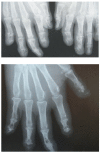Musculoskeletal involvement in sarcoidosis
- PMID: 24831403
- PMCID: PMC4083650
- DOI: 10.1590/s1806-37132014000200012
Musculoskeletal involvement in sarcoidosis
Abstract
Sarcoidosis is a multisystem inflammatory disorder of unknown cause. It most commonly affects the pulmonary system but can also affect the musculoskeletal system, albeit less frequently. In patients with sarcoidosis, rheumatic involvement is polymorphic. It can be the presenting symptom of the disease or can appear during its progression. Articular involvement is dominated by nonspecific arthralgia, polyarthritis, and Löfgren's syndrome, which is defined as the presence of lung adenopathy, arthralgia (or arthritis), and erythema nodosum. Skeletal manifestations, especially dactylitis, appear mainly as complications of chronic, multiorgan sarcoidosis. Muscle involvement in sarcoidosis is rare and usually asymptomatic. The diagnosis of rheumatic sarcoidosis is based on X-ray findings and magnetic resonance imaging findings, although the definitive diagnosis is made by anatomopathological study of biopsy samples. Musculoskeletal involvement in sarcoidosis is generally relieved with nonsteroidal anti-inflammatory drugs or corticosteroids. In corticosteroid-resistant or -dependent forms of the disease, immunosuppressive therapy, such as treatment with methotrexate or anti-TNF-α, is employed. The aim of this review was to present an overview of the various types of osteoarticular and muscle involvement in sarcoidosis, focusing on their diagnosis and management.
A sarcoidose é um distúrbio inflamatório multissistêmico de causa desconhecida, frequentemente afetando o sistema pulmonar e também o sistema músculo-esquelético, mas de forma menos frequente. Em pacientes com sarcoidose, o acometimento reumático é polimórfico, podendo ser o sintoma de apresentação da doença ou aparecer durante sua progressão. O acometimento articular é dominado por artralgia inespecífica, poliartrite e síndrome de Löfgren, que é definida como a presença de adenopatia pulmonar, artralgia (ou artrite) e eritema nodoso. Manifestações esqueléticas, especialmente dactilite, aparecem principalmente como complicações de sarcoidose crônica e em vários órgãos. O acometimento muscular na sarcoidose é raro e geralmente assintomático. O diagnóstico de sarcoidose reumática baseia-se em achados radiográficos e de ressonância magnética, embora o diagnóstico definitivo seja feito pelo estudo anatomopatológico de amostras de biópsia. O acometimento músculo-esquelético na sarcoidose é geralmente aliviado com o uso de anti-inflamatórios não esteroidais ou corticosteroides. Em formas da doença resistentes ao corticosteroide ou corticosteroide dependentes, a terapia de imunossupressão, como o tratamento com metotrexato ou anti-TNF-α, é utilizada. O objetivo desta revisão foi apresentar uma visão geral dos vários tipos de acometimento osteoarticular e muscular na sarcoidose, com foco no diagnóstico e manejo.
Figures




References
-
- Fayad F, Liote F, Berenbaum F, Orcel P, Bardin T. Muscle involvement in sarcoidosis: a retrospective and followup studies. J Rheumatol. 2006;33(1):98–103. - PubMed
-
- Statement on sarcoidosis Joint Statement of the American Thoracic Society (ATS), the European Respiratory Society (ERS) and the World Association of Sarcoidosis and Other Granulomatous Disorders (WASOG) adopted by the ATS Board of Directors and by the ERS Executive Committee, February 1999. Am J Respir Crit Care Med. 1999;160(2):736–755. doi: 10.1164/ajrccm.160.2.ats4-99. - DOI - PubMed
Publication types
MeSH terms
Substances
LinkOut - more resources
Full Text Sources
Other Literature Sources
Medical

